parking brake MERCEDES-BENZ SLK-Class 2014 R172 Owner's Manual
[x] Cancel search | Manufacturer: MERCEDES-BENZ, Model Year: 2014, Model line: SLK-Class, Model: MERCEDES-BENZ SLK-Class 2014 R172Pages: 354, PDF Size: 4.02 MB
Page 7 of 354
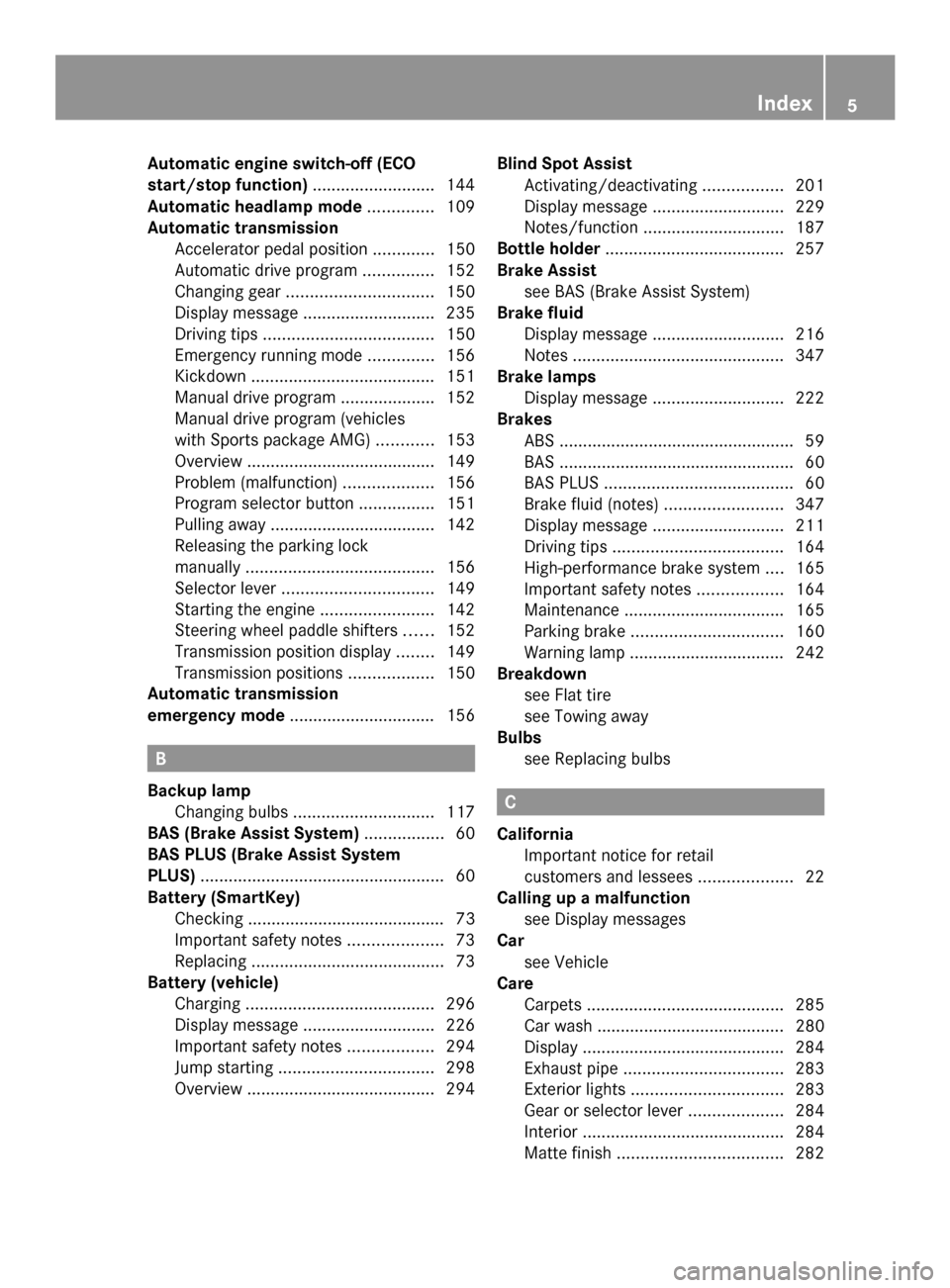
Automatic engine switch-off (ECO
start/stop function)
..........................144
Automatic headlamp mode ..............109
Automatic transmission Accelerator pedal position .............150
Automatic drive program ...............152
Changing gea r............................... 150
Display message ............................ 235
Driving tips .................................... 150
Emergency running mode ..............156
Kickdown ....................................... 151
Manual drive program ....................152
Manual drive program (vehicles
with Sports package AMG) ............153
Overview ........................................ 149
Problem (malfunction) ...................156
Program selector button ................151
Pulling away ................................... 142
Releasing the parking lock
manually ........................................ 156
Selector lever ................................ 149
Starting the engine ........................142
Steering wheel paddle shifters ......152
Transmission position displa y........ 149
Transmission positions ..................150
Automatic transmission
emergency mode ............................... 156 B
Backup lamp Changing bulbs .............................. 117
BAS (Brake Assist System) .................60
BAS PLUS (Brake Assist System
PLUS) .................................................... 60
Battery (SmartKey) Checking .......................................... 73
Important safety notes ....................73
Replacing ......................................... 73
Battery (vehicle)
Charging ........................................ 296
Display message ............................ 226
Important safety notes ..................294
Jump starting ................................. 298
Overview ........................................ 294Blind Spot Assist
Activating/deactivating .................201
Display message ............................ 229
Notes/function .............................. 187
Bottle holder ...................................... 257
Brake Assist see BAS (Brake Assist System)
Brake fluid
Display message ............................ 216
Notes ............................................. 347
Brake lamps
Display message ............................ 222
Brakes
ABS .................................................. 59
BAS .................................................. 60
BAS PLUS ........................................ 60
Brake fluid (notes) .........................347
Display message ............................ 211
Driving tips .................................... 164
High-performance brake system ....165
Important safety notes ..................164
Maintenance .................................. 165
Parking brake ................................ 160
Warning lamp ................................. 242
Breakdown
see Flat tire
see Towing away
Bulbs
see Replacing bulbs C
California Important notice for retail
customers and lessees ....................22
Calling up a malfunction
see Display messages
Car
see Vehicle
Care
Carpets .......................................... 285
Car wash ........................................ 280
Display ........................................... 284
Exhaust pipe .................................. 283
Exterior lights ................................ 283
Gear or selector lever ....................284
Interior ........................................... 284
Matte finish ................................... 282 Index
5
Page 10 of 354
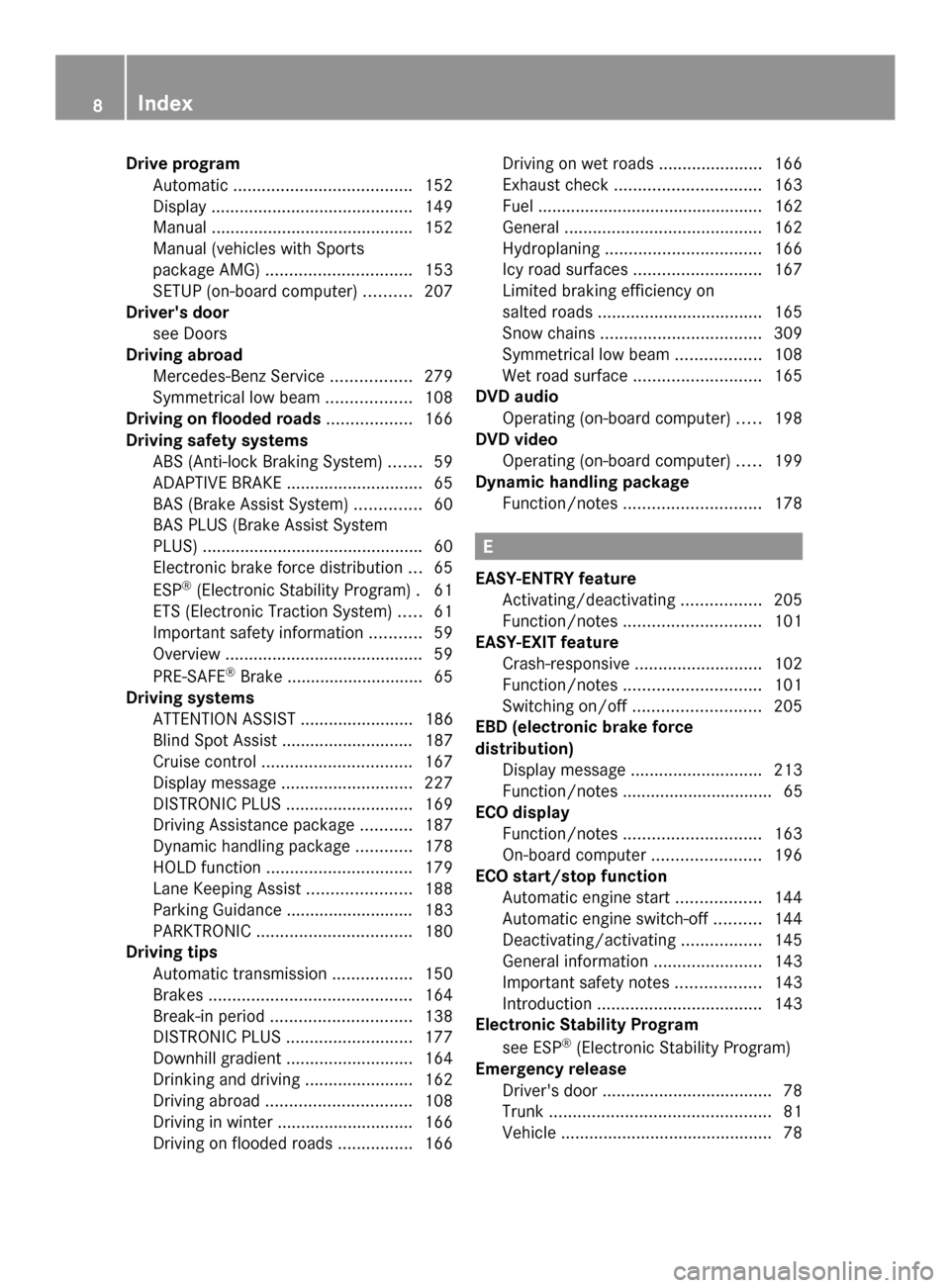
Drive program
Automatic ...................................... 152
Display ........................................... 149
Manual .......................................... .152
Manual (vehicles with Sports
package AMG) ............................... 153
SETUP (on-board computer) ..........207
Driver's door
see Doors
Driving abroad
Mercedes-Benz Service .................279
Symmetrical low bea m.................. 108
Driving on flooded roads ..................166
Driving safety systems ABS (Anti-lock Braking System) .......59
ADAPTIVE BRAKE ............................. 65
BAS (Brake Assist System) ..............60
BAS PLUS (Brake Assist System
PLUS) .............................................. .60
Electronic brake force distributio n... 65
ESP ®
(Electronic Stability Program) .61
ETS (Electronic Traction System) .....61
Important safety information ...........59
Overview .......................................... 59
PRE-SAFE ®
Brake ............................ .65
Driving systems
ATTENTION ASSIST ........................ 186
Blind Spot Assist ............................ 187
Cruise control ................................ 167
Display message ............................ 227
DISTRONIC PLUS ........................... 169
Driving Assistance package ...........187
Dynamic handling package ............178
HOLD function ............................... 179
Lane Keeping Assist ......................188
Parking Guidance ........................... 183
PARKTRONIC ................................. 180
Driving tips
Automatic transmission .................150
Brakes ........................................... 164
Break-in period .............................. 138
DISTRONIC PLUS ........................... 177
Downhill gradient ........................... 164
Drinking and driving .......................162
Driving abroad ............................... 108
Driving in winter ............................ .166
Driving on flooded roads ................166Driving on wet roads
......................166
Exhaust check ............................... 163
Fuel ................................................ 162
General .......................................... 162
Hydroplaning ................................. 166
Icy road surfaces ........................... 167
Limited braking efficiency on
salted road s................................... 165
Snow chains .................................. 309
Symmetrical low bea m.................. 108
Wet road surface ........................... 165
DVD audio
Operating (on-board computer) .....198
DVD video
Operating (on-board computer) .....199
Dynamic handling package
Function/notes ............................. 178 E
EASY-ENTRY feature Activating/deactivating .................205
Function/notes ............................. 101
EASY-EXIT feature
Crash-responsive ........................... 102
Function/notes ............................. 101
Switching on/off ........................... 205
EBD (electronic brake force
distribution)
Display message ............................ 213
Function/notes ................................ 65
ECO display
Function/notes ............................. 163
On-board computer .......................196
ECO start/stop function
Automatic engine start ..................144
Automatic engine switch-off ..........144
Deactivating/activating .................145
General information .......................143
Important safety notes ..................143
Introduction ................................... 143
Electronic Stability Program
see ESP ®
(Electronic Stability Program)
Emergency release
Driver's door .................................... 78
Trunk ............................................... 81
Vehicle ............................................. 788
Index
Page 12 of 354
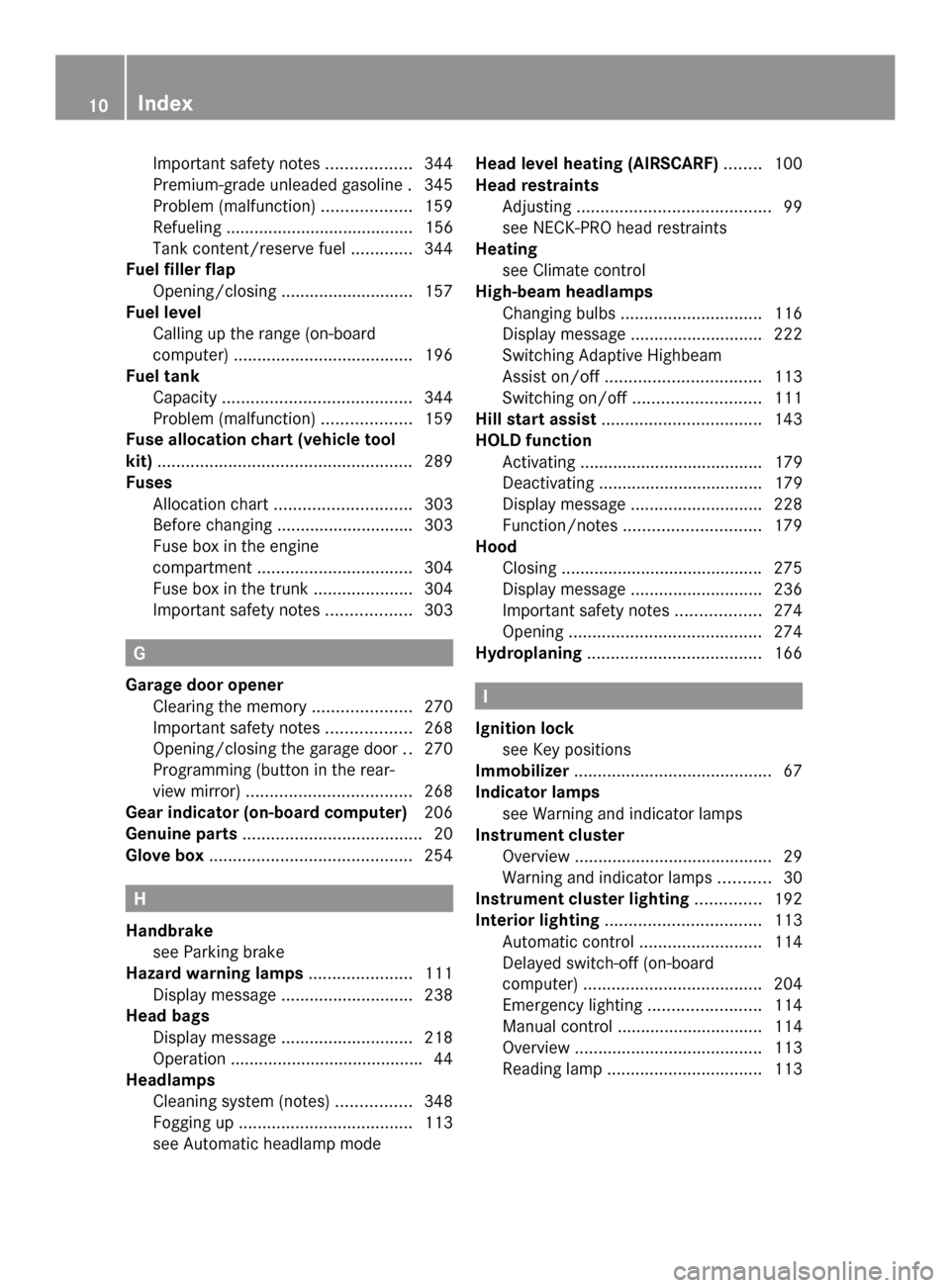
Important safety notes
..................344
Premium-grade unleaded gasoline .345
Problem (malfunction) ...................159
Refueling ........................................ 156
Tank content/reserve fuel .............344
Fuel filler flap
Opening/closing ............................ 157
Fuel level
Calling up the range (on-board
computer) ...................................... 196
Fuel tank
Capacity ........................................ 344
Problem (malfunction) ...................159
Fuse allocation chart (vehicle tool
kit) ...................................................... 289
Fuses Allocation chart ............................. 303
Before changing ............................. 303
Fuse box in the engine
compartment ................................. 304
Fuse box in the trunk .....................304
Important safety notes ..................303 G
Garage door opener Clearing the memory .....................270
Important safety notes ..................268
Opening/closing the garage door ..270
Programming (button in the rear-
view mirror) ................................... 268
Gear indicator (on-board computer) 206
Genuine parts ...................................... 20
Glove box ........................................... 254H
Handbrake see Parking brake
Hazard warning lamps ......................111
Display message ............................ 238
Head bags
Display message ............................ 218
Operation ........................................ .44
Headlamps
Cleaning system (notes) ................348
Fogging up ..................................... 113
see Automatic headlamp mode Head level heating (AIRSCARF)
........100
Head restraints Adjusting ......................................... 99
see NECK-PRO head restraints
Heating
see Climate control
High-beam headlamps
Changing bulbs .............................. 116
Display message ............................ 222
Switching Adaptive Highbeam
Assist on/off ................................. 113
Switching on/off ........................... 111
Hill start assist .................................. 143
HOLD function Activating ....................................... 179
Deactivating ................................... 179
Display message ............................ 228
Function/notes ............................. 179
Hood
Closing .......................................... .275
Display message ............................ 236
Important safety notes ..................274
Opening ......................................... 274
Hydroplaning ..................................... 166 I
Ignition lock see Key positions
Immobilizer .......................................... 67
Indicator lamps see Warning and indicator lamps
Instrument cluster
Overview .......................................... 29
Warning and indicator lamps ...........30
Instrument cluster lighting ..............192
Interior lighting ................................. 113
Automatic control ..........................114
Delayed switch-off (on-board
computer) ...................................... 204
Emergency lighting ........................114
Manual control ............................... 114
Overview ........................................ 113
Reading lamp ................................. 11310
Index
Page 15 of 354
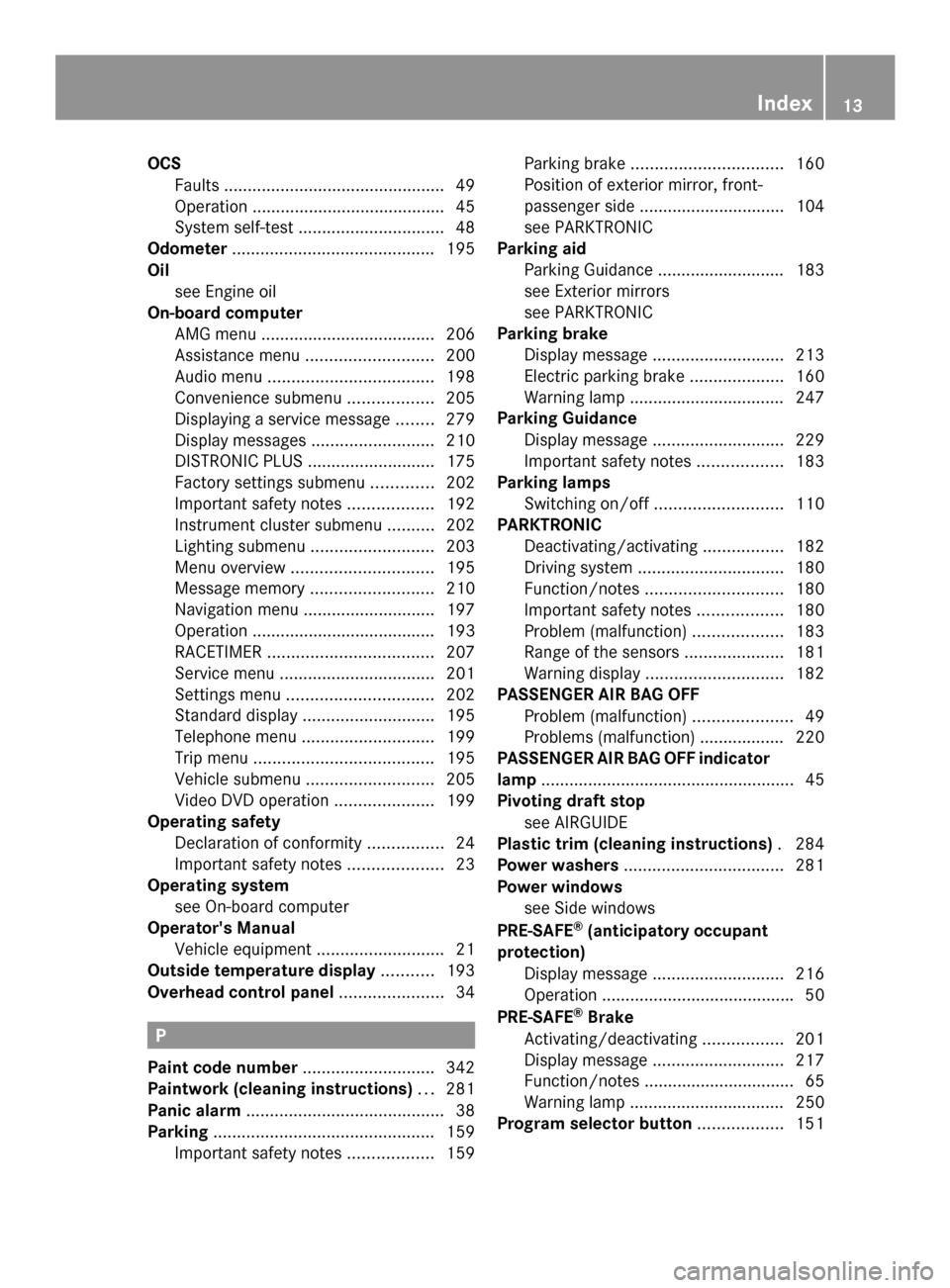
OCS
Faults .............................................. .49
Operation ........................................ .45
System self-test ............................... 48
Odometer ........................................... 195
Oil see Engine oil
On-board computer
AMG menu ..................................... 206
Assistance menu ........................... 200
Audio menu ................................... 198
Convenience submenu ..................205
Displaying a service message ........279
Display messages ..........................210
DISTRONIC PLUS ........................... 175
Factory settings submenu .............202
Important safety notes ..................192
Instrument cluster submenu ..........202
Lighting submenu .......................... 203
Menu overview .............................. 195
Message memory .......................... 210
Navigation menu ............................ 197
Operation ....................................... 193
RACETIMER ................................... 207
Service menu ................................. 201
Settings menu ............................... 202
Standard displa y............................ 195
Telephone menu ............................ 199
Trip menu ...................................... 195
Vehicle submenu ........................... 205
Video DVD operation .....................199
Operating safety
Declaration of conformity ................24
Important safety notes ....................23
Operating system
see On-board computer
Operator's Manual
Vehicle equipment ...........................21
Outside temperature display ...........193
Overhead control panel ......................34 P
Paint code number ............................342
Paintwork (cleaning instructions) ...281
Panic alarm .......................................... 38
Parking ............................................... 159
Important safety notes ..................159Parking brake
................................ 160
Position of exterior mirror, front-
passenger side ............................... 104
see PARKTRONIC
Parking aid
Parking Guidance ........................... 183
see Exterior mirrors
see PARKTRONIC
Parking brake
Display message ............................ 213
Electric parking brake ....................160
Warning lamp ................................. 247
Parking Guidance
Display message ............................ 229
Important safety notes ..................183
Parking lamps
Switching on/off ........................... 110
PARKTRONIC
Deactivating/activating .................182
Driving system ............................... 180
Function/notes ............................. 180
Important safety notes ..................180
Problem (malfunction) ...................183
Range of the sensors .....................181
Warning displa y............................. 182
PASSENGER AIR BAG OFF
Problem (malfunction) .....................49
Problems (malfunction) .................. 220
PASSENGER AIR BAG OFF indicator
lamp ...................................................... 45
Pivoting draft stop see AIRGUIDE
Plastic trim (cleaning instructions) .284
Power washers .................................. 281
Power windows see Side windows
PRE-SAFE ®
(anticipatory occupant
protection) Display message ............................ 216
Operation ........................................ .50
PRE-SAFE ®
Brake
Activating/deactivating .................201
Display message ............................ 217
Function/notes ................................ 65
Warning lamp ................................. 250
Program selector button ..................151 Index
13
Page 30 of 354

Dashboard
Function Page
0043
Steering wheel paddle
shifters
152
0044
Combination switch 110
0087
Instrument cluster 29
0085
Horn
0083
PARKTRONIC warning
display
180
0084
Overhead control panel 34
006B
Climate control systems 122
006C
Ignition lock 139
Start/Stop button
139 Function Page
006D
Adjusting the steering
wheel manually
100
006E
Adjusting the steering
wheel electrically
100
006F
Cruise control lever 168
0070
Electric parking brake 160
0071
Diagnostics connection 24
0072
Opening the hood 274
0073
Light switch 10828
Dashboa
rdAt a glance
Page 32 of 354

Warning and indicator lamps
Function Page
0043
0058
Low-beam
headlamps 109
0044
0060
Parking lamps 110
0087
0057
High-beam
headlamps 111
0085
00E5
ESP® 244
0083
0049
Electric parking brake
(red) 242
0084
0024
Electric parking brake
(yellow) 242
006B
00BA
Distance warning 250
006C
003E003D
Turn signals 110
006D
0077
Tire pressure monitor 314
006E
0075
SRS 247 Function Page
006F
00E9
Seat belt 240
0070
0074
SPORT handling
mode in AMG vehicles 245
0071
00AC
Coolant 248
0072
005E
Rear fog lamp 110
0073
005A
Front fog lamps 109
0074
00B9
Check Engine 248
0075
00B6
Reserve fuel 248
0076
00BB
ESP®
OFF 244
0077
0025
ABS 242
0078
0027
Brakes 24230
Instrument clusterAt a glance
Page 59 of 354

system manufacturer's installation
instructions.
G
WARNING
Child restraint systems or their securing
systems which have been damaged or
subjected to a load in an accident can no
longer protect as intended. The child cannot
then be restrained in the event of an accident,
heavy braking or sudden changes of direction.
There is an increased risk of injury, possibly
even fatal.
Replace child restraint systems which have
been damaged or subjected to a load in an
accident as soon as possible. Have the
securing systems on the child restraint
system checked at a qualified specialist
workshop, before you install a child restraint
system again. G
WARNING
Infants and small children should never share
a seat belt with another occupant. In the event
of an accident, they could be crushed
between the occupant and seat belt.
A child's risk of serious or fatal injuries is
significantly increased if the child restraints
are not properly secured in the vehicle and/
or the child is not properly secured in the child
restraint.
Children that are too large for a child restraint
must travel in seats using normal seat belts.
Position the shoulder belt across the chest
and shoulder, not the face or neck. A booster
seat may be necessary to achieve proper seat
belt positioning for children over 41 lbs
(18 kg) until they reach a height where a lap/
shoulder belt fits properly without a booster
seat.
When the child restraint is not in use, remove
it from the vehicle or secure it with the seat
belt to prevent the child restraint from
becoming a projectile in the event of an
accident. G
WARNING
If children are left unsupervised in the vehicle,
they could:
R open the doors, thus endangering other
people or road users.
R get out and disrupt traffic.
R operate the vehicle's equipment.
Additionally, children could set the vehicle in
motion if, for example, they:
R release the parking brake.
R shift the automatic transmission out of
parking position P.
R shift the manual transmission into neutral.
R starting the engine.
There is a risk of an accident and injury.
When leaving the vehicle, always take the
SmartKey with you and lock the vehicle. Never
leave children or animals unattended in the
vehicle. Always keep the SmartKey out of
reach of children. G
WARNING
If persons, particularly children are subjected
to prolonged exposure to extreme heat or
cold, there is a risk of injury, possibly even
fatal. Never leave children unattended in the
vehicle. G
WARNING
If the child restraint system is subjected to
direct sunlight, parts may get very hot.
Children may burn themselves on these parts,
particularly on the metal parts of the child
restraint system. There is a risk of injury.
If you leave the vehicle, taking the child with
you, always ensure that the child restraint
system is not exposed to direct sunlight.
Protect it with a blanket, for example. If the
child restraint system has been exposed to
direct sunlight, let it cool down before
securing the child in it. Never leave children
unattended in the vehicle. Child restraint systems
57Safety Z
Page 63 of 354
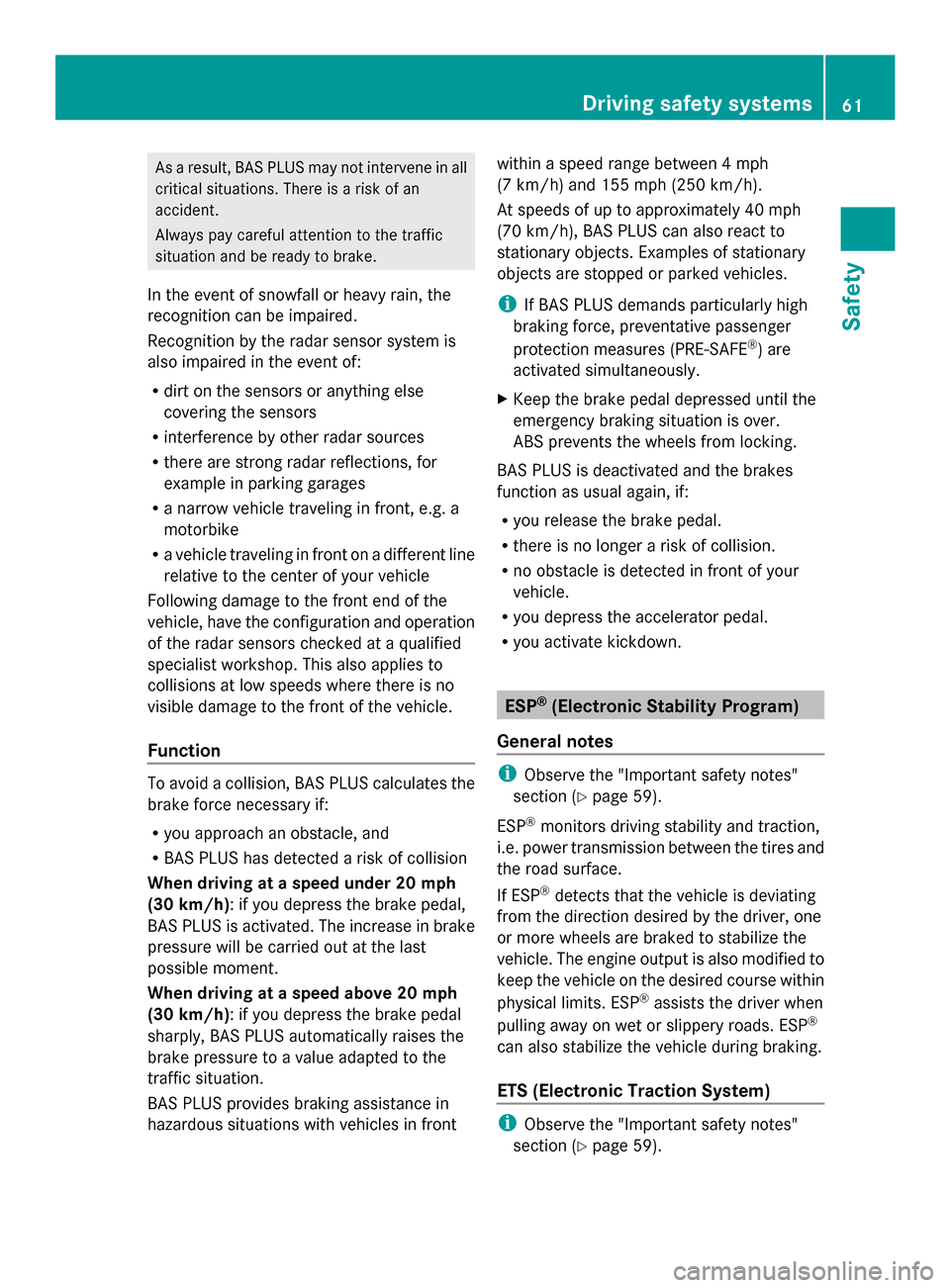
As a result, BAS PLUS may not intervene in all
critical situations. There is a risk of an
accident.
Always pay careful attention to the traffic
situation and be ready to brake.
In the event of snowfall or heavy rain, the
recognition can be impaired.
Recognition by the radar sensor system is
also impaired in the event of:
R dirt on the sensors or anything else
covering the sensors
R interference by other radar sources
R there are strong radar reflections, for
example in parking garages
R a narrow vehicle traveling in front, e.g. a
motorbike
R a vehicle traveling in front on a different line
relative to the center of your vehicle
Following damage to the front end of the
vehicle, have the configuration and operation
of the radar sensors checked at a qualified
specialist workshop. This also applies to
collisions at low speeds where there is no
visible damage to the front of the vehicle.
Function To avoid a collision, BAS PLUS calculates the
brake force necessary if:
R you approach an obstacle, and
R BAS PLUS has detected a risk of collision
When driving at a speed under 20 mph
(30 km/h): if you depress the brake pedal,
BAS PLUS is activated. The increase in brake
pressure will be carried out at the last
possible moment.
When driving at a speed above 20 mph
(30 km/h): if you depress the brake pedal
sharply, BAS PLUS automatically raises the
brake pressure to a value adapted to the
traffic situation.
BAS PLUS provides braking assistance in
hazardous situations with vehicles in front within a speed range between 4 mph
(7 km/h) and 155 mph (250 km/h).
At speeds of up to approximately 40 mph
(70 km/h), BAS PLUS can also react to
stationary objects. Examples of stationary
objects are stopped or parked vehicles.
i
If BAS PLUS demands particularly high
braking force, preventative passenger
protection measures (PRE-SAFE ®
) are
activated simultaneously.
X Keep the brake pedal depressed until the
emergency braking situation is over.
ABS prevents the wheels from locking.
BAS PLUS is deactivated and the brakes
function as usual again, if:
R you release the brake pedal.
R there is no longer a risk of collision.
R no obstacle is detected in front of your
vehicle.
R you depress the accelerator pedal.
R you activate kickdown. ESP
®
(Electronic Stability Program)
General notes i
Observe the "Important safety notes"
section ( Ypage 59).
ESP ®
monitors driving stability and traction,
i.e. power transmission between the tires and
the road surface.
If ESP ®
detects that the vehicle is deviating
from the direction desired by the driver, one
or more wheels are braked to stabilize the
vehicle. The engine output is also modified to
keep the vehicle on the desired course within
physical limits. ESP ®
assists the driver when
pulling away on wet or slippery roads. ESP ®
can also stabilize the vehicle during braking.
ETS (Electronic Traction System) i
Observe the "Important safety notes"
section ( Ypage 59). Driving safety systems
61Safety Z
Page 64 of 354
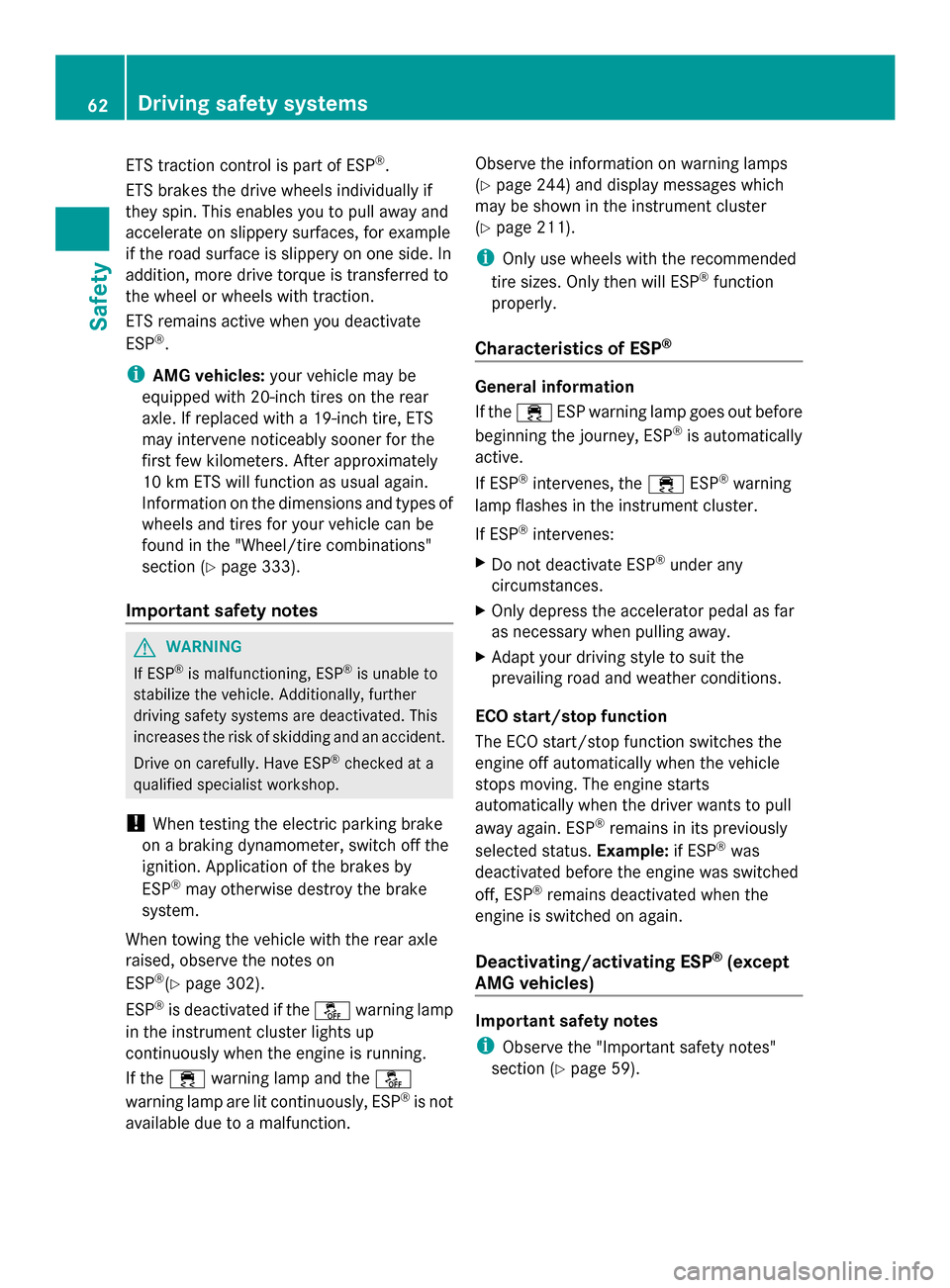
ETS traction control is part of ESP
®
.
ETS brakes the drive wheels individually if
they spin. This enables you to pull away and
accelerate on slippery surfaces, for example
if the road surface is slippery on one side. In
addition, more drive torque is transferred to
the wheel or wheels with traction.
ETS remains active when you deactivate
ESP ®
.
i AMG vehicles: your vehicle may be
equipped with 20-inch tires on the rear
axle. If replaced with a 19-inch tire, ETS
may intervene noticeably sooner for the
first few kilometers. After approximately
10 km ETS will function as usual again.
Information on the dimensions and types of
wheels and tires for your vehicle can be
found in the "Wheel/tire combinations"
section ( Ypage 333).
Important safety notes G
WARNING
If ESP ®
is malfunctioning, ESP ®
is unable to
stabilize the vehicle. Additionally, further
driving safety systems are deactivated. This
increases the risk of skidding and an accident.
Drive on carefully. Have ESP ®
checked at a
qualified specialist workshop.
! When testing the electric parking brake
on a braking dynamometer, switch off the
ignition. Application of the brakes by
ESP ®
may otherwise destroy the brake
system.
When towing the vehicle with the rear axle
raised, observe the notes on
ESP ®
(Y page 302).
ESP ®
is deactivated if the 00BBwarning lamp
in the instrument cluster lights up
continuously when the engine is running.
If the 00E5 warning lamp and the 00BB
warning lamp are lit continuously, ESP ®
is not
available due to a malfunction. Observe the information on warning lamps
(Y
page 244) and display messages which
may be shown in the instrument cluster
(Y page 211).
i Only use wheels with the recommended
tire sizes. Only then will ESP ®
function
properly.
Characteristics of ESP ® General information
If the
00E5 ESP warning lamp goes out before
beginning the journey, ESP ®
is automatically
active.
If ESP ®
intervenes, the 00E5ESP®
warning
lamp flashes in the instrument cluster.
If ESP ®
intervenes:
X Do not deactivate ESP ®
under any
circumstances.
X Only depress the accelerator pedal as far
as necessary when pulling away.
X Adapt your driving style to suit the
prevailing road and weather conditions.
ECO start/stop function
The ECO start/stop function switches the
engine off automatically when the vehicle
stops moving. The engine starts
automatically when the driver wants to pull
away again. ESP ®
remains in its previously
selected status. Example:if ESP®
was
deactivated before the engine was switched
off, ESP ®
remains deactivated when the
engine is switched on again.
Deactivating/activating ESP ®
(except
AMG vehicles) Important safety notes
i
Observe the "Important safety notes"
section ( Ypage 59). 62
Driving safety systemsSafety
Page 68 of 354
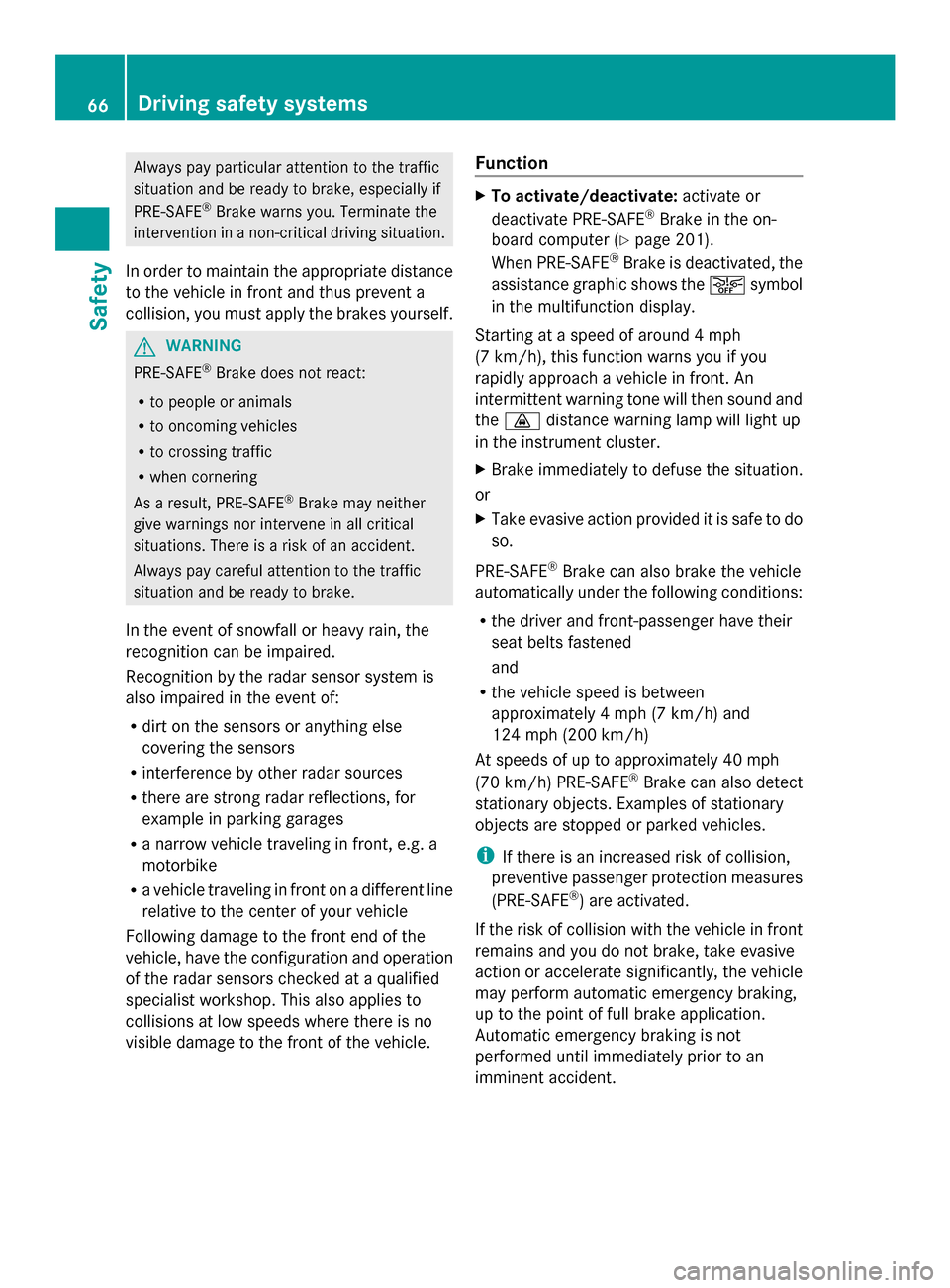
Always pay particular attention to the traffic
situation and be ready to brake, especially if
PRE-SAFE ®
Brake warns you. Terminate the
intervention in a non-critical driving situation.
In order to maintain the appropriate distance
to the vehicle in front and thus prevent a
collision, you must apply the brakes yourself. G
WARNING
PRE-SAFE ®
Brake does not react:
R to people or animals
R to oncoming vehicles
R to crossing traffic
R when cornering
As a result, PRE-SAFE ®
Brake may neither
give warnings nor intervene in all critical
situations. There is a risk of an accident.
Always pay careful attention to the traffic
situation and be ready to brake.
In the event of snowfall or heavy rain, the
recognition can be impaired.
Recognition by the radar sensor system is
also impaired in the event of:
R dirt on the sensors or anything else
covering the sensors
R interference by other radar sources
R there are strong radar reflections, for
example in parking garages
R a narrow vehicle traveling in front, e.g. a
motorbike
R a vehicle traveling in front on a different line
relative to the center of your vehicle
Following damage to the front end of the
vehicle, have the configuration and operation
of the radar sensors checked at a qualified
specialist workshop. This also applies to
collisions at low speeds where there is no
visible damage to the front of the vehicle. Function X
To activate/deactivate: activate or
deactivate PRE-SAFE ®
Brake in the on-
board computer (Y page 201).
When PRE-SAFE ®
Brake is deactivated, the
assistance graphic shows the 00D4symbol
in the multifunction display.
Starting at a speed of around 4 mph
(7 km/h), this function warns you if you
rapidly approach a vehicle in front. An
intermittent warning tone will then sound and
the 00BA distance warning lamp will light up
in the instrument cluster.
X Brake immediately to defuse the situation.
or
X Take evasive action provided it is safe to do
so.
PRE-SAFE ®
Brake can also brake the vehicle
automatically under the following conditions:
R the driver and front-passenger have their
seat belts fastened
and
R the vehicle speed is between
approximately 4 mph (7 km/h) and
124 mph (200 km/h)
At speeds of up to approximately 40 mph
(70 km/h) PRE-SAFE ®
Brake can also detect
stationary objects. Examples of stationary
objects are stopped or parked vehicles.
i If there is an increased risk of collision,
preventive passenger protection measures
(PRE-SAFE ®
) are activated.
If the risk of collision with the vehicle in front
remains and you do not brake, take evasive
action or accelerate significantly, the vehicle
may perform automatic emergency braking,
up to the point of full brake application.
Automatic emergency braking is not
performed until immediately prior to an
imminent accident. 66
Driving safety systemsSafety